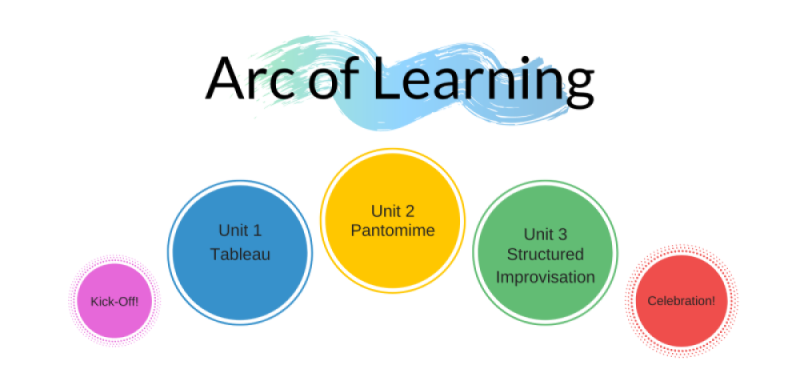




Drama Frames is a job-embedded professional development program from Childsplay. Teachers work one-on-one with theatre teaching artists, and develop skills to incorporate drama as a tool for supporting instruction of class curriculum.
Along with being dynamic and imaginative theater artists, professional Teaching Artists have extensive classrom experience, sharply-honed lesson planning techniques, and strong classroom management skills. Our Teaching Artists will proivde a journey inclusive of both academic and artistic learning for your students. We've spent the past few months learning about how to teach online in an effective and engaging way, and we're ready to partner with you and your students!
We have a current plan for the program to begin in early February and through mid-May. Many elements of the program will have felixibility in scheduling including (classroom lessons and planning sessions with teaching artist). 10 hours of the Professional develpment will be synchronistic in-service training with a hybrid of remote sessions and in-person meetings sheduled in advance.
Initially developed in 2006, the Drama Frames professional development was further iterated and tested with research grants from the U.S. Department of Education and the Helios Foundation, illustrating Childsplay's expertise in developing and sustaining impactful educational programs for various educational settings, including preschool classrooms, dual-language environments, and online learning.
In the last 17 years Drama Frames has been implemented in over a hundred classrooms across Maricopa county. Some of our previous school district partners include Washington Elementary, Osborn, and Avondale.
Drama Frames follows the "I do, we do, you do" model of skill transfer. Theatre teaching artists collaborate with teachers during a 3-unit learning arc. Each unit pairs a drama-based instructional strategy with English Language Standards from the Arizona Department of Education. Core concepts are introduced (teaching artist model lesson), scaffolded (in-service training, team lesson with teaching artist and classroom teacher), and implemented (classroom teacher-led solo lesson). This partnership provides hands-on mentorship and facilitates the transition to teacher-led drama-integrated lessons. The program provides a flexible framework for educators to create lessons specific to their curricula and community. By focusing on kinesthetic expression and student choice, Drama Frames lessons systematically target critical literacy and language skills, promote differentiated instruction, and integrate into existing curricula.

Drama integration is a powerful tool for re-engaging students and improving their ELA skills. Research shows that drama-based activities like story retelling, embodied thinking, and character exploration significantly enhance literacy and language learning (Lee et al., 2015). Drama also has the potential to boost emotional literacy, a key predictor of academic success (Pianta, 1999; Torres et al., 2015). Behavioral and emotional engagement, in particular, have been identified as significant predictors of reading performance (Lee et al., 2014). Importantly, drama strategies are particularly effective tools for diverse learners, including those disproportionately impacted by COVID-19. It engages emergent bilingual students, students with disabilities, and those with behavioral challenges in ways that traditional literacy lessons may not (Kilinc et al., 2017; Bernstein et al., 2022). In Drama-Integrated Learning, students have opportunities to contribute ideas in literacy activities through movement, gesture, and facial expression (Barnett, 1998).
Each drama frame unit aligns drama-based instructional strategies with Arizona's ELA standards. And research partnerships with Arizona State University confirm the program's efficacy. Findings identified significant improvements in student engagement and English Language Arts (ELA) proficiency. For instance, when implemented at Washington Elementary School District, 88% of teachers felt the program positively impacted their students' overall attitude toward learning, and 68% of students reported increased interest in writing. Students who participated in Drama Frames in the Osborn School District demonstrated significant gains on NWEA Measures of Academic Progress (MAP) scores in the areas of foundational skills, literature, and vocabulary compared to their control group peers.
Furthermore, 76% of educators intend to continue using the drama strategies, highlighting the program's long-term value.
For more about the case for arts education, click here >
Dr. Lauren Van Huistede from Mary Lou Fulton Teacher's College at Arizona State University is involved with project as primary investigator. Participating teachers in Drama Frames will provide information about teaching strategies and how usage of drama-integrated lessons evolved during the semester.
Not to worry! We are happy to help - contact our Education team below!
Katie Brantley at kbrantley@childsplayaz.org
Laura Alarcon at alarcon@childsplayaz.org
Join our Educator mailing list and forward to someone who might be interested! Follow us on Facebook, Instagram, or Twitter @ChildsplayAZ to like, share, tag us! Your recommendations are our most valuable marketing resource.